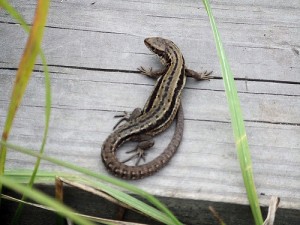 THE WAY IN
The mind has a way of taking control. Scientists call our Amygdala–the region of our brain pretty much in charge of feelings of anxiety, fear, anger and negativity–our “lizard brain.” Why lizard brain? Because this area of our brain evolved a loooong time ago, back when our primal lizard-ish concerns were much more prevalent. This is why our biological stress response to, say, a looming deadline, is still as dramatic as it was when were facing, say, a looming tiger.
The Amygdala, two small organs in the brain each about the size of a small almond, can become overstimulated by ongoing stressors and begin to run the show–our lives. The more we feel the stress response, the more the Amygdala are activated. The more the Amygdala stay activated, the more we begin to feel that this state is normal. Fear, anger and negativity become our primary modus operandus.
THE WAY OUT
Life Coach revolutionary Martha Beck teaches clients to not only identify their inner lizards, but to name them. Queen B, Mack, Merv and Miss Thang. Just some options to get you thinking about what you might call yours. Where’s the benefit in naming your lizard? We work with thoughts and label them as “planning” “rehashing” “fantasizing” or “imagining” in order to help us remember we are separate from our thoughts and don’t have to jump on board with them all the time. Naming our lizards helps us let them do their thing, so we can continue to do ours.
And what’s ours? Finding our freedom. Living our dreams.
Examples? You got it.
Here’s some from other people’s lizards that they’ve told me along the way:
“If you quit the job you hate you’ll be poor and living in a box on the street.”
“You can’t start your own business. It will ruin you.”
“Saying ‘no’ to that invitation will make that person stop asking you.”
“If you act as smart as you are, people won’t like you.”
“If you rest, your competition will pass you by.”
5 Ways to Work With Your Inner Lizard
THE WAY IN
The mind has a way of taking control. Scientists call our Amygdala–the region of our brain pretty much in charge of feelings of anxiety, fear, anger and negativity–our “lizard brain.” Why lizard brain? Because this area of our brain evolved a loooong time ago, back when our primal lizard-ish concerns were much more prevalent. This is why our biological stress response to, say, a looming deadline, is still as dramatic as it was when were facing, say, a looming tiger.
The Amygdala, two small organs in the brain each about the size of a small almond, can become overstimulated by ongoing stressors and begin to run the show–our lives. The more we feel the stress response, the more the Amygdala are activated. The more the Amygdala stay activated, the more we begin to feel that this state is normal. Fear, anger and negativity become our primary modus operandus.
THE WAY OUT
Life Coach revolutionary Martha Beck teaches clients to not only identify their inner lizards, but to name them. Queen B, Mack, Merv and Miss Thang. Just some options to get you thinking about what you might call yours. Where’s the benefit in naming your lizard? We work with thoughts and label them as “planning” “rehashing” “fantasizing” or “imagining” in order to help us remember we are separate from our thoughts and don’t have to jump on board with them all the time. Naming our lizards helps us let them do their thing, so we can continue to do ours.
And what’s ours? Finding our freedom. Living our dreams.
Examples? You got it.
Here’s some from other people’s lizards that they’ve told me along the way:
“If you quit the job you hate you’ll be poor and living in a box on the street.”
“You can’t start your own business. It will ruin you.”
“Saying ‘no’ to that invitation will make that person stop asking you.”
“If you act as smart as you are, people won’t like you.”
“If you rest, your competition will pass you by.”
5 Ways to Work With Your Inner Lizard
“Sometimes we need to take the leap, before we grow the wings to fly.” – If you know who said this, please fill us in!RELATED A really cheesy but useful video that is actually an ad for Seth Godin‘s book but worth watching anyway. F’realz.
1 Comment
Hello how would I stop anxiety for good from the thoughts and the fear and been more happy iv had it for 5 months now and just want my life back how could I do that. Many thanks michael